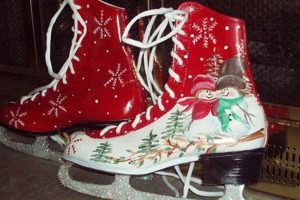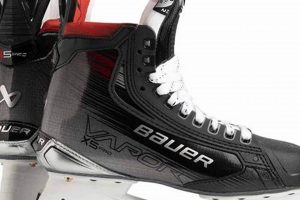Maintaining a sharp blade on ice skates is essential for optimal performance and safety on the ice. A dull blade compromises an skater’s ability to grip the ice, leading to reduced control, increased effort, and a higher risk of falls. Regularly addressing the blade’s sharpness ensures clean edges that bite into the ice, facilitating precise turns, powerful strides, and overall improved skating experience.
The ability to appropriately adjust blade sharpness is not merely a convenience; it provides significant advantages. It allows for immediate resolution of blade degradation during intensive skating sessions, saving valuable ice time. It also translates to long-term cost savings, reducing reliance on professional sharpening services. The historical practice of blade maintenance dates back to the earliest forms of ice skating, evolving from rudimentary methods to more sophisticated techniques to suit the demands of competitive and recreational skating.
This article provides a detailed overview of the techniques and tools involved in maintaining the blades at home, offering a practical guide for skaters seeking to keep their equipment in top condition. Discussion will cover the equipment required, step-by-step procedures for proper execution, and essential safety considerations to prevent injury and damage to the blades.
Tips for Maintaining Ice Skate Blade Sharpness
Proper maintenance is critical for maximizing blade lifespan and performance. The following guidelines offer insight into preventative measures and techniques.
Tip 1: Regular cleaning of the blade after each use is essential. Wipe the blade with a soft cloth to remove moisture, debris, and any accumulated ice particles. This prevents corrosion and maintains the integrity of the blade’s edge.
Tip 2: Use blade guards when walking on surfaces other than ice. Hard surfaces, such as concrete or rubber, will quickly dull the edges. Ensure the guards are clean and dry to prevent moisture build-up.
Tip 3: Invest in a skate sharpening stone specifically designed for ice skate blades. A fine-grit stone can be used to touch up the edges between professional sharpenings, extending the period between formal servicing.
Tip 4: Employ a consistent sharpening technique. Maintaining a uniform angle and pressure while using a sharpening stone will result in an even edge. Uneven sharpening can lead to imbalanced performance on the ice.
Tip 5: Avoid over-sharpening the blade. Excessive sharpening removes material unnecessarily, shortening the lifespan of the blade. Sharpen only when performance indicates a need.
Tip 6: Store skates in a dry environment. Moisture accelerates corrosion and dulls the blades. Consider using moisture-absorbing packets inside the skate bag to maintain a dry environment.
Tip 7: Regularly inspect the blades for nicks or damage. Even minor imperfections can affect performance. Address any issues promptly to prevent further degradation.
Adhering to these maintenance practices will result in improved blade longevity, consistent on-ice performance, and reduced need for professional servicing. By implementing these preventative measures, skaters can optimize their equipment and enhance their overall skating experience.
The following section provides guidance regarding the tools necessary and steps involved for sharpening.
1. Equipment selection
The selection of appropriate equipment is a fundamental determinant in the successful execution of ice skate sharpening. The tools employed directly influence the quality, precision, and longevity of the sharpened blade. Inadequate or inappropriate equipment can result in suboptimal edge quality, blade damage, and potential injury.
- Sharpening Stone Grit
The grit of the sharpening stone directly affects the aggressiveness of the sharpening process. Coarse-grit stones are suitable for removing significant material or repairing damaged edges, while fine-grit stones are essential for honing and polishing the blade to achieve a smooth, sharp edge. Selection of the appropriate grit based on the blade’s condition is paramount to preventing over-sharpening or inadequate material removal. For routine maintenance, a fine-grit stone is generally recommended.
- Sharpening Stone Material
Sharpening stones are available in various materials, including ceramic, diamond, and oil stones. Each material exhibits distinct properties regarding hardness, durability, and heat dissipation. Diamond stones, known for their aggressive cutting action, are effective for harder steel alloys but require careful handling to prevent over-sharpening. Ceramic stones offer a balance between cutting ability and durability, while oil stones require the use of honing oil to facilitate smooth cutting and prevent clogging. The choice of material should align with the skate blade’s steel composition and the user’s sharpening skill level.
- Honing Oil (If Applicable)
When using oil stones, the selection of an appropriate honing oil is crucial. The oil serves as a lubricant, reducing friction between the stone and the blade, and helps carry away swarf (metal particles) produced during sharpening. Using the wrong type of oil, or no oil at all, can lead to clogging of the stone’s pores, reduced cutting efficiency, and potential damage to the blade. Lighter, low-viscosity oils are generally preferred for honing stones.
- Blade Holders/Vises
Securing the skate blade during sharpening is essential for maintaining consistent angles and preventing slippage, which can result in uneven sharpening or injury. Blade holders or vises provide a stable platform for the skate, allowing for controlled movement of the sharpening stone along the blade’s edge. Adjustable vises that can accommodate different blade thicknesses are particularly advantageous.
The interplay of the above equipment is paramount to achieving a professional-grade result. An appropriately selected suite of equipment contributes directly to the quality of the blade’s edge, affecting glide, grip, and overall skating performance. Neglecting the importance of equipment selection can lead to suboptimal results, blade damage, and potential safety hazards.
2. Angle consistency
Angle consistency is a critical factor in achieving a proper edge during the sharpening process. Maintaining a uniform angle between the sharpening stone and the skate blade is essential for creating an even and effective edge along the entire length of the blade. Deviation from a consistent angle results in an uneven edge, leading to compromised performance on the ice. An inconsistent angle may result in sections of the blade that are sharper than others. It can also result in a rounding of the desired sharp edge. The desired result is a clean edge that bites into the ice to allow for turns, stops and acceleration.
Achieving angle consistency requires practice and careful attention to technique. A common method involves visualizing a fixed angle and maintaining that angle throughout the sharpening stroke. Some sharpening aids incorporate angle guides to assist in maintaining consistency. However, relying solely on visual cues or guides does not guarantee perfect consistency. Developing muscle memory through repetitive practice is vital. For example, during practice, focus should be on a slow consistent sweep of the stone across the blade. A consistent slow pace will result in a more consistent angle across the blade.
The practical significance of angle consistency lies in its direct impact on skating performance. A blade with an inconsistent edge will not grip the ice effectively, leading to reduced control and increased effort. Correcting angle inconsistencies often requires professional intervention, incurring additional cost and time. Therefore, prioritizing angle consistency is essential for skaters aiming to maintain their equipment and maximize their performance.
3. Pressure control
Pressure control is a significant factor in effective skate sharpening. The amount of force applied when drawing a sharpening stone across a blades edge determines the rate of material removal and the quality of the resulting edge. Improper pressure management can degrade blade geometry, shortening the lifespan. An understanding of appropriate force is required for controlled blade maintenance.
- Consistent Force Application
Maintaining uniform pressure is essential to ensure an even grind along the entire blade. Inconsistent pressure leads to uneven material removal, resulting in an asymmetrical edge. For example, applying more pressure at the heel of the blade than at the toe will create a blade that is sharper at the heel, affecting balance and control. Consistent pressure application contributes directly to a balanced, responsive blade.
- Minimizing Over-Sharpening
Excessive pressure removes material unnecessarily, reducing the blade’s lifespan and potentially altering its intended profile. Over-sharpening leads to a blade that is too aggressive, requiring increased effort to control and potentially causing premature wear. Applying light pressure and making multiple passes is generally preferable to applying heavy pressure in a single pass.
- Adjusting Pressure for Blade Condition
The amount of pressure required varies depending on the blade’s condition. A blade with minor imperfections or needing only a touch-up requires minimal pressure, while a blade with significant damage or dullness requires more assertive material removal. The ability to assess blade condition and adjust pressure accordingly is a key skill in at-home sharpening.
- The Role of Sharpening Stone Grit
The grit of the sharpening stone interacts directly with pressure control. A coarser grit requires less pressure to remove material, while a finer grit requires more. Applying excessive pressure with a coarse grit can lead to over-sharpening and damage, while insufficient pressure with a fine grit may result in ineffective sharpening. Selecting the appropriate stone and pressure combination is crucial for achieving the desired result.
The interplay of these pressure-related factors determines the final quality of the sharpened blade. Understanding these principles is essential for anyone performing at-home sharpening, and mastery of these principles can prolong blade life and improve on-ice performance.
4. Blade inspection
Blade inspection is an indispensable component of any at-home ice skate sharpening process. It serves as the foundation for determining the necessity and methodology of sharpening. A thorough examination of the blade reveals existing damage, identifies areas requiring attention, and informs decisions regarding the appropriate sharpening techniques and tools to employ. Without proper inspection, sharpening becomes a blind process, potentially exacerbating existing problems or introducing new ones. For instance, attempting to sharpen a blade with a deep nick without first addressing the damage could result in an uneven edge or further weakening of the blade’s structure. Therefore, blade inspection is causally linked to the success and safety of at-home sharpening.
The practical application of blade inspection involves several steps. First, the blade is visually assessed for any signs of damage, such as nicks, burrs, rust, or uneven wear. A tactile inspection, using a gloved hand, can reveal subtle imperfections that may not be visible. The presence of rust indicates the need for rust removal before sharpening. The severity of nicks or burrs dictates the level of coarseness required for the sharpening stone. In cases of severe damage, professional repair or replacement may be necessary. Proper inspection also identifies areas where the blade may have lost its original profile, requiring corrective action during sharpening.
In conclusion, blade inspection forms the bedrock of a conscientious ice skate sharpening regimen. It allows for a targeted approach, ensuring that sharpening efforts are focused on addressing specific issues and preserving the blade’s structural integrity. By understanding the condition of the blade prior to sharpening, skaters can optimize their maintenance efforts, prolong the life of their equipment, and maintain optimal performance on the ice.
5. Safety precautions
The endeavor to maintain ice skate blades, specifically through at-home sharpening, presents inherent risks necessitating strict adherence to safety precautions. The tools involved, such as sharpening stones and metal files, possess the potential to cause lacerations or abrasions if handled improperly. Furthermore, the skate blades themselves, designed for cutting into ice, present a significant hazard if safety measures are not prioritized. A failure to implement adequate safety protocols can lead to injuries, equipment damage, and an overall compromise of the sharpening process. For example, a lapse in concentration while using a sharpening stone could result in a deep cut to the hand. Likewise, inadequate securing of the skate blade during sharpening could lead to the skate slipping and causing injury or damage to surrounding surfaces. Therefore, safety precautions serve as a critical, preventative component of at-home ice skate sharpening.
The implementation of robust safety measures translates directly into a safer and more efficient sharpening process. Wearing cut-resistant gloves provides a physical barrier against accidental lacerations. Utilizing a secure blade holding device or vise minimizes the risk of slippage during sharpening. Furthermore, maintaining a clean and well-lit workspace reduces the likelihood of accidents caused by poor visibility or tripping hazards. Eye protection is also essential to prevent metal filings from entering the eyes. The application of these measures not only reduces the risk of injury but also fosters a more focused and controlled sharpening environment, leading to improved results. An example would be to use a vise-grip and ensure there is no play while working with the blade.
In summary, integrating safety precautions into the at-home ice skate sharpening process is not merely a recommendation but a fundamental requirement. Neglecting these measures exposes the individual to unnecessary risks and potentially compromises the quality of the sharpening outcome. By prioritizing safety through the use of appropriate protective equipment, secure work practices, and a well-maintained workspace, skaters can effectively sharpen their blades while minimizing the potential for injury and equipment damage. The challenges associated with at-home sharpening are mitigated through diligence and the consistent application of safety protocols, reinforcing the importance of safety as an indispensable element of successful blade maintenance. Ultimately, safety is not an option, but the foundation for effective maintenance.
Frequently Asked Questions
This section addresses common inquiries regarding at-home ice skate sharpening, providing concise and factual responses to assist in effective blade maintenance.
Question 1: What constitutes a “dull” skate blade?
A blade is considered dull when it no longer provides sufficient grip on the ice, requiring increased effort for turns, stops, and acceleration. Visually, a dull blade may exhibit rounded edges, while a sharp blade possesses distinct, defined edges.
Question 2: How frequently should ice skates be sharpened?
Sharpening frequency depends on usage intensity and ice quality. As a general guideline, skaters should sharpen their blades every 20-40 hours of ice time. Regular inspection of the blade’s edge is the most reliable indicator of sharpness.
Question 3: Can any type of sharpening stone be used for ice skates?
No. Only sharpening stones specifically designed for steel blades should be used. Avoid using stones intended for other purposes, as they may be too abrasive or incompatible with the steel alloy of skate blades.
Question 4: Is at-home sharpening suitable for all skill levels?
At-home sharpening is best suited for individuals with experience and a steady hand. Novice skaters should consider professional sharpening services until they develop the necessary skills and understanding of blade maintenance.
Question 5: What are the potential risks of improper at-home sharpening?
Improper sharpening can lead to uneven edges, blade damage, reduced lifespan, and potential safety hazards. Over-sharpening weakens the blade, while uneven sharpening compromises balance and control on the ice.
Question 6: How can the longevity of a sharpened skate blade be maximized?
Blade longevity is maximized by proper maintenance practices, including regular cleaning, using blade guards when walking off the ice, and avoiding contact with abrasive surfaces. Proper storage in a dry environment also prevents corrosion and extends blade life.
Effective at-home skate maintenance, when performed correctly, can prolong blade life and enhance skating performance. However, diligence and precision are crucial, and professional services should be considered when in doubt.
The subsequent section will summarize the critical factors discussed and provide concluding guidance for maintaining ice skate blades.
Conclusion
The comprehensive process of ice skate blade maintenance, including the methods of how do you sharpen ice skates at home, has been explored. Critical aspects, such as equipment selection, angle consistency, pressure control, blade inspection, and safety precautions, are vital for achieving a functional and safe blade. The ability to maintain blades at home necessitates a thorough understanding of these principles and a commitment to practicing them meticulously.
Optimal performance and safety are contingent upon adherence to these guidelines. While at-home sharpening offers convenience and cost savings, it is essential to recognize its limitations. When uncertainty exists or advanced repairs are required, professional services are imperative. Prioritizing blade maintenance safeguards equipment and provides an optimal skating experience.







